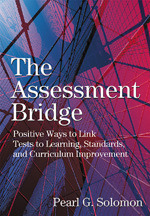
The Assessment Bridge
Positive Ways to Link Tests to Learning, Standards, and Curriculum Improvement
- Pearl G. Solomon - St. Thomas Aquinas College
Leadership & Management | Standards & Accountability | Summative Assessment & Testing
A clear-headed and cogent analysis of how High-Stakes Standards-Based (HSSB) tests affect student learning, teacher training, curriculum and instruction, and school administration and leadership. Covers the origins and history of the current testing movement and analyzes how the proper balance of standardized tests, curriculum standards, and locally controlled variables (socioeconomic status, class size, teacher attitudes) can help schools focus their energies for maximum effect and build bridges from test anxiety to better learning and better schools.
"Just the kind of bridge we need to span the ideological wars and make schools work for teachers and their students."
"In her supremely well-written and useful book, Dr. Solomon has woven together historical perspective, research, and her own considerable experience to address reforming schools in the 21st Century. After defining the problem (productive change), Dr. Solomon has examined "old" solutions and conceptualized new ones to create better schools for students. She has focused the reader's attention on critical issues to be addressed--restructuring curriculum around assessment to inform instruction; selecting, training, and retaining the best teachers; and developing shared leadership--and has offered useful and practical suggestions to address them."
"Standards and implementation of the learning process go hand in hand. The Assessment Bridge makes us clearly aware of the present need for a bridge between the two so that standards may not create greater failure and the rejection of formal education by many children."
"This book presents the needed material to follow from Dr. Solomon’s work on standards and curriculum. It completes the bridge from goals to accountability by introducing a better understanding of assessment. It will allow educators to better comprehend the key instructional issues that we face."
"Dr. Solomon's latest is, once again, a gem. The Assessment Bridge offers a wealth of concrete tools and examples to support schools, administrators, and teachers in providing meaningful student learning experiences in (and despite) a high-stakes testing environment. Her reflections and inquiry on her own teaching and learning experiences are woven throughout, and present a unique context and historical perspective that somehow make this task possible. It will be high on my list of recommended resource books."